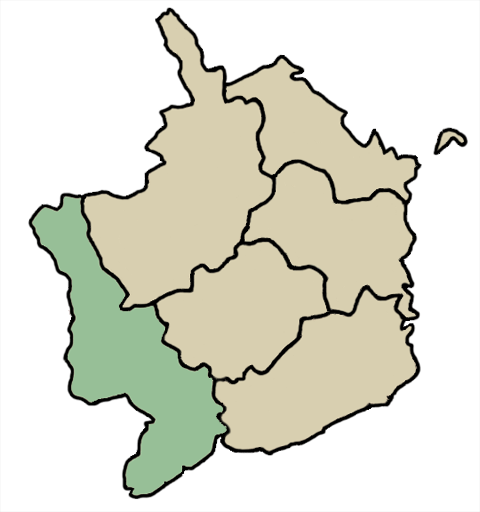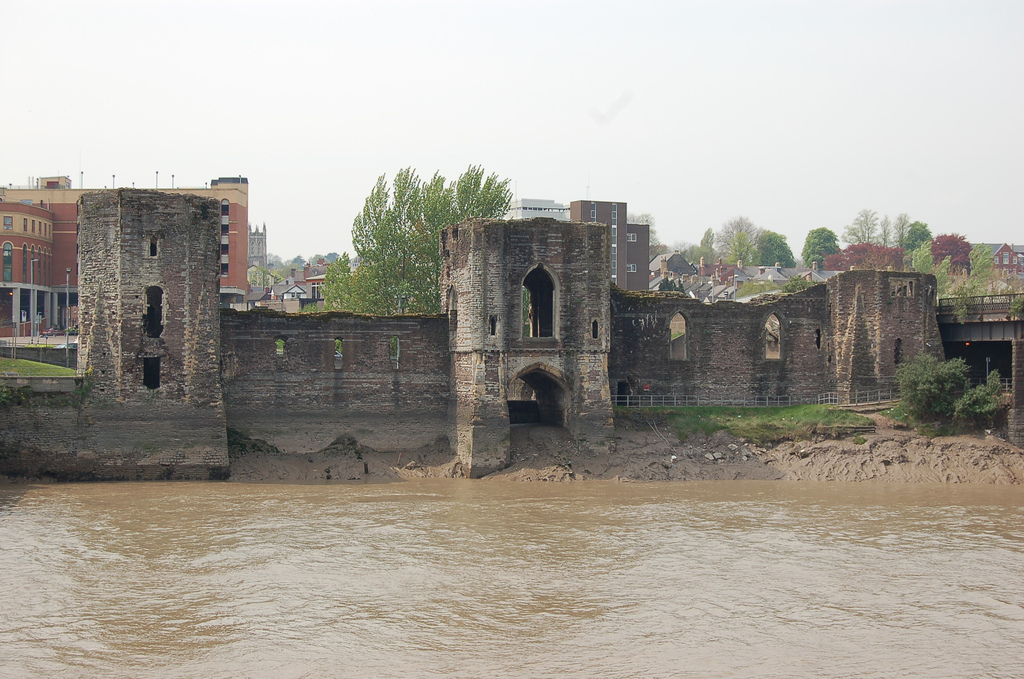|
Gwynllŵg
Gwynllŵg was a monarchy, kingdom of mediaeval Wales and later a Normans, Norman Marcher Lords, lordship and then a Wentloog (hundred), cantref. Location It was named after Gwynllyw, its 5th century or 6th century ruler and consisted of the coastal plain stretching between the Rhymney River, Rhymney and River Usk, Usk rivers, together with the hills to the north. It was traditionally regarded as part of the kingdom of Glamorgan (), rather than that of Kingdom of Gwent, Gwent which extended only as far westwards as the River Usk. However, under the Laws in Wales Acts of 1535–42, the hundred was included with those situated to the east, to form the new county of Monmouthshire (historic), Monmouthshire. Wentloog and St. Woolos The name ''Gwynllŵg'' became a marcher lordship (alternatively called Newport). The name survives as 'Wentloog' in the Wentloog (hundred), Wentloog hundred and in villages on the coastal plain such as Peterstone Wentloog and St Brides Wentloog. The name ... [...More Info...] [...Related Items...] OR: [Wikipedia] [Google] [Baidu] |
Wentloog
Wentlooge ( cy, Gwynllŵg), sometimes known as Wentloog, is a community in the southwest of the city of Newport, South Wales, in the Marshfield ward. The community includes Peterstone Wentloodge and St. Brides Wentloodge and in 2011 had a population of 737. Description The name Wentlooge is a corruption of the earlier name Gwynllŵg, said to have been named after Gwynllyw, its 5th - 6th century ruler. The community is bounded by Percoed reen to the northwest, the Ebbw River to the northeast, the Bristol Channel to the southeast and the South Wales Main Line to the southwest. It contains the hamlets of St Brides Wentloog and Peterstone Wentloog.Wentlooge Community Council Wentlooge Community Council homepage. Retrieved 18 March 2016. The [...More Info...] [...Related Items...] OR: [Wikipedia] [Google] [Baidu] |
Wentloog (hundred)
Wentloog (also known as Wentlloog and Wentllooge) was an ancient hundred of Monmouthshire. It was also known as Newport hundred. It was situated in the western part of the county, bounded to the north by Brecknockshire; on the east by the hundreds of Abergavenny, Usk and Caldicot; on the south by the Bristol Channel, and on the west by Glamorganshire. ''Wentloog'' is an anglicisation of the Welsh ''Gwynllŵg'', the name of the early kingdom and medieval ''cantref''. It contained the following ancient parishes: *Aberystruth *Bassaleg: consisting of Duffryn township, Graig hamlet and Rogerstone township *Bedwas *Bedwellty * Bettws *Coedkernew * Henllys * Llanfihangel Llantarnam * Llanhilleth *Machen * Malpas * Marshfield *Michaelston y vedw *Mynyddislwyn * Newport *Peterstone Wentlooge *Risca * Rumney *St. Brides Wentlooge * St. Mellons * St. Woolos The area is now administered by several local authorities, in particular Newport, Torfaen, Blaenau Gwent and Caerphi ... [...More Info...] [...Related Items...] OR: [Wikipedia] [Google] [Baidu] |
Kingdom Of Gwent
Gwent ( owl, Guent) was a medieval Welsh kingdom, lying between the Rivers Wye and Usk. It existed from the end of Roman rule in Britain in about the 5th century until the Norman invasion of Wales in the 11th century. Along with its neighbour Glywyssing, it seems to have had a great deal of cultural continuity with the earlier Silures,Miranda Aldhouse-Green &al. ''Gwent In Prehistory and Early History: The Gwent County History'', Vol.1. 2004. . keeping their own courts and diocese separate from the rest of Wales until their conquest by Gruffydd ap Llywelyn. Although it recovered its independence after his death in 1063, Gwent was the first of the Welsh kingdoms to be overrun following the Norman conquest. History Establishment The area has been occupied since the Paleolithic, with Mesolithic finds at Goldcliff and evidence of growing activity throughout the Bronze and Iron Age. Gwent came into being after the Romans had left Britain, and was a successor state drawing on t ... [...More Info...] [...Related Items...] OR: [Wikipedia] [Google] [Baidu] |
St Brides Wentloog
St. Bride's or St. Bride's Wentloog ( cy, Llansanffraid Gwynllŵg) is a small hamlet to the south west of the city of Newport in South Wales. Location It lies in the parish of Wentlooge and electoral district (ward) of Marshfield. Like most of the settlements on the Wentloog Level it lies on land behind the sea wall, reclaimed from the Bristol Channel, and criss-crossed by large and small drainage ditches, known locally as reens. History The village and church of St. Bride's, Wentloog is dedicated to St. Bridget. St Brides church is an ancient building of stone in the Decorated and Perpendicular styles, and consists of chancel, nave, south porch and an unusually fine perpendicular embattled western tower containing 6 bells, four of which are dated 1734 and bear inscriptions. A plaque inside the porch marks the high-tide level of the Bristol Channel floods of 1607. It was the birthplace of Lyn Harding David Llewellyn Harding (12 October 1867 – 26 December 1 ... [...More Info...] [...Related Items...] OR: [Wikipedia] [Google] [Baidu] |
Peterstone Wentloog
Peterstone or Peterstone Wentlooge ( cy, Llanbedr Gwynllŵg) is a small hamlet to the south west of the city of Newport, South Wales. Location Peterstone Wentlooge lies six miles to the west of Newport city centre and 7½ miles east of Cardiff city centre. It lies in the community parish of Wentloog and electoral ward of Marshfield. History and amenities Like most of the settlements on the Wentlooge Level it lies on land reclaimed from the Bristol Channelbr> Peterstone itself lies right against the sea wallbr> an The former parish church, St Peter's Church, Wentlooge, St Peter's is now a private hous [...More Info...] [...Related Items...] OR: [Wikipedia] [Google] [Baidu] |
Monarchy
A monarchy is a form of government in which a person, the monarch, is head of state for life or until abdication. The political legitimacy and authority of the monarch may vary from restricted and largely symbolic (constitutional monarchy), to fully autocratic (absolute monarchy), and can expand across the domains of the executive, legislative, and judicial. The succession of monarchs in many cases has been hereditical, often building dynastic periods. However, elective and self-proclaimed monarchies have also happened. Aristocrats, though not inherent to monarchies, often serve as the pool of persons to draw the monarch from and fill the constituting institutions (e.g. diet and court), giving many monarchies oligarchic elements. Monarchs can carry various titles such as emperor, empress, king, queen, raja, khan, tsar, sultan, shah, or pharaoh. Monarchies can form federations, personal unions and realms with vassals through personal association with the monarch, whi ... [...More Info...] [...Related Items...] OR: [Wikipedia] [Google] [Baidu] |
History Of Monmouthshire
History (derived ) is the systematic study and the documentation of the human activity. The time period of event before the invention of writing systems is considered prehistory. "History" is an umbrella term comprising past events as well as the memory, discovery, collection, organization, presentation, and interpretation of these events. Historians seek knowledge of the past using historical sources such as written documents, oral accounts, art and material artifacts, and ecological markers. History is not complete and still has debatable mysteries. History is also an academic discipline which uses narrative to describe, examine, question, and analyze past events, and investigate their patterns of cause and effect. Historians often debate which narrative best explains an event, as well as the significance of different causes and effects. Historians also debate the nature of history as an end in itself, as well as its usefulness to give perspective on the problems of the p ... [...More Info...] [...Related Items...] OR: [Wikipedia] [Google] [Baidu] |
Kingdoms Of Wales
Wales in the Middle Ages covers the history of the country that is now called Wales, from the departure of the Romans in the early fifth century, the development of regional Welsh kingdoms and Celtic conflict with the Anglo-Saxons, reducing Celtic territories. Conflict also occurred between the Welsh and the Anglo-Normans from the 11th century until the annexation of Wales into the Kingdom of England in the early sixteenth century. Early Middle Ages: 411–1066 When the Roman garrison of Britain was withdrawn in 410, the various British states were left self-governing. Evidence for a continuing Roman influence after the departure of the Roman legions is provided by an inscribed stone from Gwynedd dated between the late 5th and mid-6th centuries commemorating a certain Cantiorix who was described as a citizen (''cives'') of Gwynedd and a cousin of Maglos the magistrate (''magistratus''). There was considerable Irish colonisation in Dyfed, where there are many stones with ogham ... [...More Info...] [...Related Items...] OR: [Wikipedia] [Google] [Baidu] |
History Of Newport, Wales
Newport ( cy, Casnewydd; ) is a city and county borough in Wales, situated on the River Usk close to its confluence with the Severn Estuary, northeast of Cardiff. With a population of 145,700 at the 2011 census, Newport is the third-largest authority with city status in Wales, and seventh most populous overall. Newport became a unitary authority in 1996 and forms part of the Cardiff-Newport metropolitan area. Newport was the site of the last large-scale armed insurrection in Great Britain, the Newport Rising of 1839. Newport has been a port since medieval times when the first Newport Castle was built by the Normans. The town outgrew the earlier Roman town of Caerleon, immediately upstream and now part of the borough. Newport gained its first charter in 1314. It grew significantly in the 19th century when its port became the focus of coal exports from the eastern South Wales Valleys. Newport was the largest coal exporter in Wales until the rise of Cardiff in the mid-1800s. I ... [...More Info...] [...Related Items...] OR: [Wikipedia] [Google] [Baidu] |
Newport, Wales
Newport ( cy, Casnewydd; ) is a city and Local government in Wales#Principal areas, county borough in Wales, situated on the River Usk close to its confluence with the Severn Estuary, northeast of Cardiff. With a population of 145,700 at the 2011 census, Newport is the third-largest authority with City status in the United Kingdom, city status in Wales, and seventh List of Welsh principal areas, most populous overall. Newport became a unitary authority in 1996 and forms part of the Cardiff-Newport metropolitan area. Newport was the site of the last large-scale armed insurrection in Great Britain, the Newport Rising of 1839. Newport has been a port since medieval times when the first Newport Castle was built by the Normans. The town outgrew the earlier Roman Britain, Roman town of Caerleon, immediately upstream and now part of the borough. Newport gained its first Municipal charter, charter in 1314. It grew significantly in the 19th century when its port became the focus of Coa ... [...More Info...] [...Related Items...] OR: [Wikipedia] [Google] [Baidu] |
St Woolos Cathedral, Newport
Newport Cathedral (Welsh; ''Eglwys Gaderiol Casnewydd''), also known as Gwynllyw, St Gwynllyw's or St Woolos' Cathedral, is the cathedral of the Diocese of Monmouth within the Church in Wales, and the seat of the Bishop of Monmouth. Its official title is Newport Cathedral of St Woolos, King and Confessor. The name of the saint, Woolos, is an anglicisation of the Welsh name Gwynllyw. It became a cathedral in 1949 and while it is the size of a large parish church rather than a typical cathedral, its history and development from the sixth to the twentieth century make it arguably one of the most interesting religious buildings in Wales. St Gwynllyw The church was founded by Gwynllyw, St Gwynllyw, who lived in the later fifth-century, after the Roman Britain, Roman occupation, at a time when Wales was beginning to develop a national identity. Gwynllyw was the King of Gwynllwg, an area which lay between later Glamorgan and Kingdom of Gwent, Gwent. He was undoubtedly a real person, ... [...More Info...] [...Related Items...] OR: [Wikipedia] [Google] [Baidu] |



.jpg)


